Related Research Articles
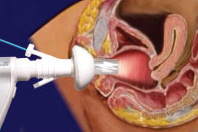
Gynaecology or gynecology is the area of medicine that involves the treatment of women's diseases, especially those of the reproductive organs. It is often paired with the field of obstetrics, forming the combined area of obstetrics and gynecology (OB-GYN).

In vitro fertilisation (IVF) is a process of fertilisation where an egg is combined with sperm in vitro. The process involves monitoring and stimulating a female's ovulatory process, removing an ovum or ova from their ovaries and letting sperm fertilise them in a culture medium in a laboratory. After the fertilised egg (zygote) undergoes embryo culture for 2–6 days, it is transferred by catheter into the uterus, with the intention of establishing a successful pregnancy.
Infertility is the inability of a person, animal or plant to reproduce by natural means. It is usually not the natural state of a healthy adult, except notably among certain eusocial species. It is the normal state of a human child or other young offspring, because they have not undergone puberty, which is the body's start of reproductive capacity.
Fertility is the ability to conceive a child. The fertility rate is the average number of children born during an individuals lifetime and is quantified demographically. Conversely, infertility is the difficulty or inability to reproduce naturally. In general, infertility is defined as not being able to conceive a child after one year of unprotected sex. Infertility is widespread, with fertility specialists available all over the world to assist parents and couples who experience difficulties conceiving a baby.
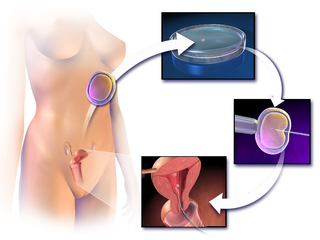
Assisted reproductive technology (ART) includes medical procedures used primarily to address infertility. This subject involves procedures such as in vitro fertilization (IVF), intracytoplasmic sperm injection (ICSI), cryopreservation of gametes or embryos, and/or the use of fertility medication. When used to address infertility, ART may also be referred to as fertility treatment. ART mainly belongs to the field of reproductive endocrinology and infertility. Some forms of ART may be used with regard to fertile couples for genetic purpose. ART may also be used in surrogacy arrangements, although not all surrogacy arrangements involve ART. The existence of sterility will not always require ART to be the first option to consider, as there are occasions when its cause is a mild disorder that can be solved with more conventional treatments or with behaviors based on promoting health and reproductive habits.
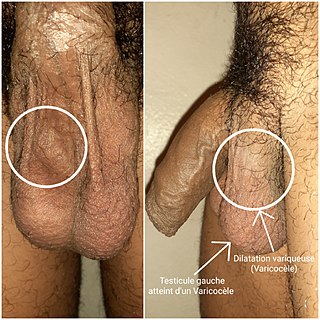
A varicocele is an abnormal enlargement of the pampiniform venous plexus in the scrotum. This plexus of veins drains blood from the testicles back to the heart. The vessels originate in the abdomen and course down through the inguinal canal as part of the spermatic cord on their way to the testis. Varicoceles occur in around 15% to 20% of all men. The incidence of varicocele increase with age.
Terms oligospermia, oligozoospermia, and low sperm count refer to semen with a low concentration of sperm and is a common finding in male infertility. Often semen with a decreased sperm concentration may also show significant abnormalities in sperm morphology and motility. There has been interest in replacing the descriptive terms used in semen analysis with more quantitative information.

The American Society for Reproductive Medicine (ASRM) is a nonprofit, multidisciplinary organization for advancement of the science and practice of reproductive medicine. The society has its headquarters in Washington, D.C and its administrative office in Birmingham, Alabama.

Letrozole, sold under the brand name Femara among others, is an aromatase inhibitor medication that is used in the treatment of breast cancer.
Male infertility refers to a sexually mature male's inability to impregnate a fertile female. In humans it accounts for 40–50% of infertility. It affects approximately 7% of all men. Male infertility is commonly due to deficiencies in the semen, and semen quality is used as a surrogate measure of male fecundity. More recently, advance sperm analyses that examine intracellular sperm components are being developed.
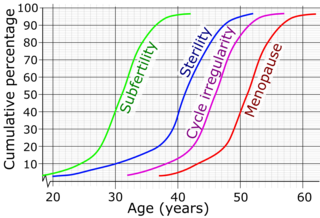
Female infertility refers to infertility in women. It affects an estimated 48 million women, with the highest prevalence of infertility affecting women in South Asia, Sub-Saharan Africa, North Africa/Middle East, and Central/Eastern Europe and Central Asia. Infertility is caused by many sources, including nutrition, diseases, and other malformations of the uterus. Infertility affects women from around the world, and the cultural and social stigma surrounding it varies.
The Creighton Model FertilityCare System is a form of natural family planning which involves identifying the fertile period during a woman's menstrual cycle. The Creighton Model was developed by Thomas Hilgers, the founder and director of the Pope Paul VI Institute. This model, like the Billings ovulation method, is based on observations of cervical mucus to track fertility. Creighton can be used for both avoiding pregnancy and achieving pregnancy.

Lactational amenorrhea, also called postpartum infertility, is the temporary postnatal infertility that occurs when a woman is amenorrheic and fully breastfeeding.

Reproductive medicine is a branch of medicine concerning the male and female reproductive systems. It encompasses a variety of reproductive conditions, their prevention and assessment, as well as their subsequent treatment and prognosis.
The American Association for Laboratory Animal Science (AALAS) is a 501(c)(3) nonprofit membership association, established in 1950 as a forum for the exchange of information and expertise in the care and use of laboratory animals. Membership consists of approximately 12,000 individual, institutional, commercial and affiliate members. The national office is located in Memphis, TN.
Reproductive endocrinology and infertility (REI) is a surgical subspecialty of obstetrics and gynecology that trains physicians in reproductive medicine addressing hormonal functioning as it pertains to reproduction as well as the issue of infertility. While most REI specialists primarily focus on the treatment of infertility, reproductive endocrinologists are trained to also test and treat hormonal dysfunctions in females and males outside infertility. Reproductive endocrinologists have specialty training (residency) in obstetrics and gynecology (ob-gyn) before they undergo sub-specialty training (fellowship) in REI.

Enclomifene (INN), or enclomiphene (USAN), a nonsteroidal selective estrogen receptor modulator of the triphenylethylene group acts by antagonizing the estrogen receptor (ER) in the pituitary gland, which reduces negative feedback by estrogen on the hypothalamic-pituitary-gonadal axis, thereby increasing gonadotropin secretion and hence gonadal production of testosterone. It is one of the two stereoisomers of clomifene, which itself is a mixture of 38% zuclomifene and 62% enclomifene. Enclomifene is the (E)-stereoisomer of clomifene, while zuclomifene is the (Z)-stereoisomer. Whereas zuclomifene is more estrogenic, enclomifene is more antiestrogenic. In accordance, unlike enclomifene, zuclomifene is antigonadotropic due to activation of the ER and reduces testosterone levels in men. As such, isomerically pure enclomifene is more favorable than clomifene as a progonadotropin for the treatment of male hypogonadism.
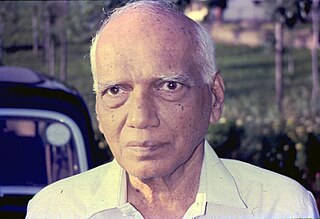
Natteri Veeraraghavan (1913-2004) was an Indian physician, microbiologist and medical researcher, known for his contributions to the understanding of diseases like rabies, tuberculosis and leprosy. He was a former director of the Pasteur Institute of India, Coonoor and the chairman of the World Health Organization International Reference Center on Rabies. He was honoured by the Government of India in 1967, with the award of Padma Shri, the fourth highest Indian civilian award for his contributions to the society.
Arjunan Rajasekaran is an Indian urologist and one of the pioneers of male infertility therapy in India. He is a former Professor and Head of the Department of Urology at the Madras Medical College, the founder of Madras Andrology and Assisted Reproduction Research Centre, a Chennai-based male infertility clinic, and a recipient of Dr. B. C. Roy Award, the highest Indian award in the medical category. He heads the National Board of Examinations as its president, the highest academic position in the medical sector in India. The Government of India awarded him the fourth highest civilian honour of the Padma Shri, in 2008, for his contributions to medical science.
Infertility and childlessness stigmas are social and cultural codes that identify the inability to have children as a disgraceful state of being. Broadly speaking, in many cultures, "Demonstrating fertility is necessary to be considered a full adult, a real man or woman, and to leave a legacy after death," and thus the failure to make this demonstration is penalized. Both male infertility and female infertility can be stigmatized, however, in many traditional cultures, women are held responsible for child-rearing and thus for pregnancy or the lack thereof. Infertility and childlessness stigmas are related to disability or physical-deformity stigmas and violation-of-group-norm stigmas. Infertility is a "deeply intimate matter, often deemed as taboo to discuss publicly."
No one wants to tell their mother-in-law.
References
- ↑ Rutstein, Shea O. and Iqbal H. Shah. 2004. Infecundity, Infertility, and Childlessness in Developing Countries. DHS Comparative Reports No. 9. Calverton, Maryland, USA: ORC Macro and the World Health Organization https://dhsprogram.com/publications/publication-cr9-comparative-reports.cfm